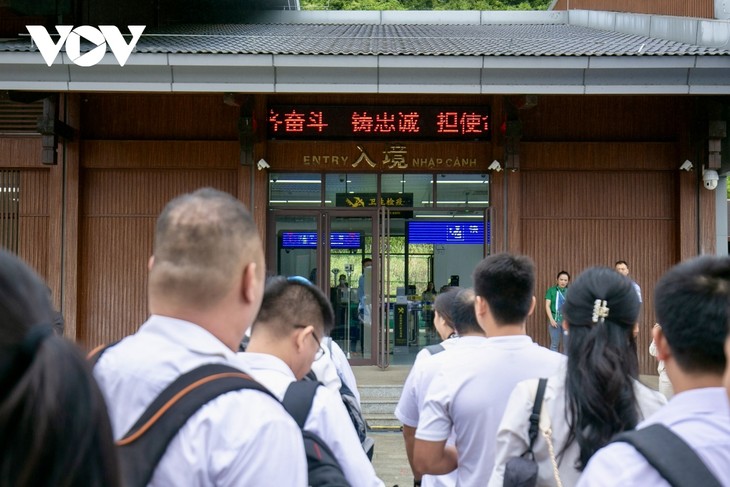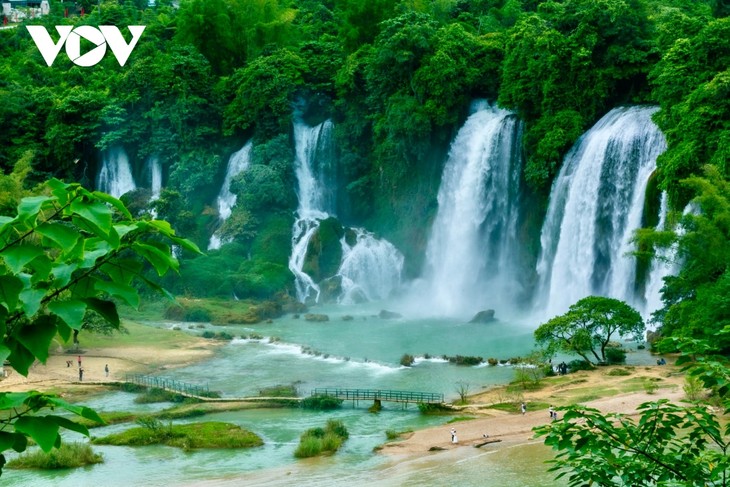(VOVWORLD) -In addition to beautiful natural landscapes and outstanding cultural features, Cao Bang province has a 333-kilometer border with China and attractive tourist destinations close to that border. Cao Bang has decided that border tourism will be a major contributor to its socio-economic development.
 The customs procedure for tourists to visit China has never been as convenient as it is now. The customs procedure for tourists to visit China has never been as convenient as it is now. |
Nguyen Mai Huong, a tourist from Hung Yen province, holds her border crossing permit waiting for exit procedures at the border gate of Trung Khanh district, Cao Bang province. Huong says she and her family have traveled to China many times, but the customs procedure has never been as convenient as it is now.
“In the past, it was difficult to travel to China because we had to go by plane and it took a long time to find the right tour, apply for a visa, and exchange money. When Cao Bang province opened its tourism routes to China, we no longer had to spend much time and effort on customs procedures,” said Huong.
Since last September, Vietnam and China have piloted a program for tourists to travel back and forth between Ban Gioc waterfall in Vietnam and Detian waterfall in China. Traveling has become easier as tourists need only their passport or border crossing permit. They don’t need a visa. Travelers who don’t have these documents just need to provide their personal information to a travel agency one day in advance to complete the procedures.
 The 333-kilometer border with China offers Cao Bang province a great potential to develop border tourism and exploit cross-border one-day tours. The 333-kilometer border with China offers Cao Bang province a great potential to develop border tourism and exploit cross-border one-day tours. |
To attract more tourists, both sides have added more attractions and increased the length of stay allowed for tourists. Many art programs have been created to introduce the culture of the people living in the border area of each country.
Nguyen Kien Cuong, head of the Cao Bang Economic Zone Management Board, said the Cao Bang administration is making it easier for travel businesses to create and operate cross-border tours.
“Cao Bang has a variety of cross-border one-day tours and other tourism itineraries. Crossing the Tra Linh international border gate, Chinese tourists can visit Thang Hen Lake, Hole Mountain, and other scenic spots in one day,” said Cuong, adding, “And Vietnamese tourists can also take one-day tours to China. Every day tour buses from other provinces cross the Tra Linh border gate to China. Since it was upgraded to an international border crossing, travel has become more convenient.”
Hoang Thi Du, returning to Vietnam after a six-hour tour to Detian waterfall in China, said she was very excited about this visit. “It was very crowded today because they held a carnival. There were many stalls selling souvenirs and different types of food. Tourists and local Chinese people attended the event and there was a lot of singing,” said Du.
Travel companies agree that cross-border tourism is a high-potential resource for Cao Bang. According to Nguyen Thi Hai Nam, who works for a company that provides tours of both Ban Gioc waterfall in Vietnam and Detian waterfall in China, her company plans to create tours to explore other famous landmarks on both sides of the border.
“Every day we serve one or two Vietnamese groups and one or two Chinese groups. We hope to receive help from the administration to offer new tourism products such as entertainment and shopping spots to enhance the tourism experience,” said Nam.
Cao Bang province's tourism industry continues to promulgate mechanisms and policies to fully tap its advantages and potentials for development.